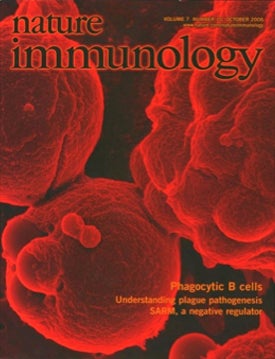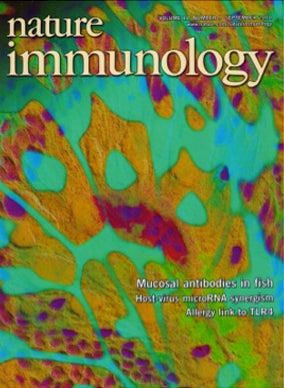Research Focus
The studies of Dr. Sunyer’s lab focus on basic and applied aspects of the fish immune system. Moreover, as teleost fish represent the most ancient living bony species with an immunoglobulin-bSunyer nature fig 1ased adaptive immune system, we use these species to study key aspects of the evolution of adaptive immunity. Our main animal model is the Rainbow trout. While earlier work focused on investigating the structure, function, and evolution of fish complement (see below refs# 1-7), during the last seven years our studies have mainly focused on B cells and mucosal immunity aspects of teleost fish.
In 2006 we reported for the first time that primary B cells from a vertebrate animal (a teleost fish) contained potent phagocytic and bactericidal capacities (Fig. 1 and ref# 6). This signified a paradigm shift since B cells were not recognized as professional phagocytes. Later in 2012, we found for the first time subsets of mammalian sunyer JLB fig 2B-1 B cells with phagocytic and bactericidal capacities (Fig. 2 and ref# 17). Critically, these cells were able to present particulate antigen to CD4+ T cells.
Another primary interest of our lab is the study of fish mucosal immune responses. In 2010 we reported the first mucosal immunoglobulin (IgT) in the gut of a teleost fish (Fig. 3, ref# 17). In this study, IgT exemplified the most ancient mucosal immunoglobulin found in a vertebrate species. Thus, this finding represented a paradigm shift as the dogma at that time dictated that mucosal immunoglobulins had evolved first in tetrapod species. Later in 2013, we showed that IgT comprised the main immunoglobulin in the mucosa of the fish skin, thus supporting further the concept that IgT is a mucosal immunoglobulin (ref# 28). Both in the gut and the skin we have shown that IgT is the main immunoglobulin responding to mucosal pathogens (refs# 17 and 28). Conversely, we have demonstrated that IgM-specific responses are IgT B cells, Rainbow Trout, and Sunyer predominantly found in the serum of the same animals. Thus, teleost fish generate compartmentalized immunoglobulin responses against pathogens: while IgT plays a key role in mucosal areas, IgM is the principal immunoglobulin response in systemic immunity. Critically, we have also found that IgT is the main immunoglobulin coating the microbiota of the fish gut and skin (refs# 17 and 28), similar to the immune exclusion role of IgA in mammals. Thus, a strong interest of our lab is to understand the regulation of fish microbiota by IgT, as well as to ascertain the role of microbiota in modulating fish immunity.
Our findings on IgT mucosal responses are not only of interest at the basic level but have important implications for the way that fish vaccines will be designed and tested, as a large number of fish pathogens enter through the skin and gut mucosal areas (ref# 19 and 29). In that regard, our laboratory is currently assessing the induction of IgT immune and protective responses upon vaccination through different routes (i.e., oral, bath, injection). Moreover, we are also developing immunostimulants that stimulate strong immune and protective mucosal immunity in farmed fish.
In addition to the above-mentioned projects, we are currently analyzing the interactions of the different rainbow trout B cell subsets with T cells. To this end, we have recently generated mAb antibodies against rainbow trout CD4-1 and CD4-2 molecules. These mAbs have enabled us to identify and functionally characterize subpopulations of CD4-T cells in this species (manuscript in preparation). We are interested in assessing B-T cell interactions in mucosal and systemic lymphoid organs of rainbow trout, including the ability of trout APCs (i.e., phagocytic B cells, macrophages) in presenting antigen to the different subsets of systemic and mucosal trout CD4-T cells. Understanding B-T cell interactions will be crucial for the future design of more effective fish vaccines and immunostimulants.
From an evolutionary perspective, our studies are relevant to deciphering unresolved paradigms of the mammalian immune system, and thus, we are using rainbow trout as a model to address several aspects of mammalian phagocytic B cells and mucosal immunity (ref# 24).
It is important to mention that the antibodies generated in our lab that have already been reported in peer-reviewed journals, are being freely shared and distributed to other research groups. See under the “Antibodies Distribution” section for the availability of antibody reagents and how to obtain them.



